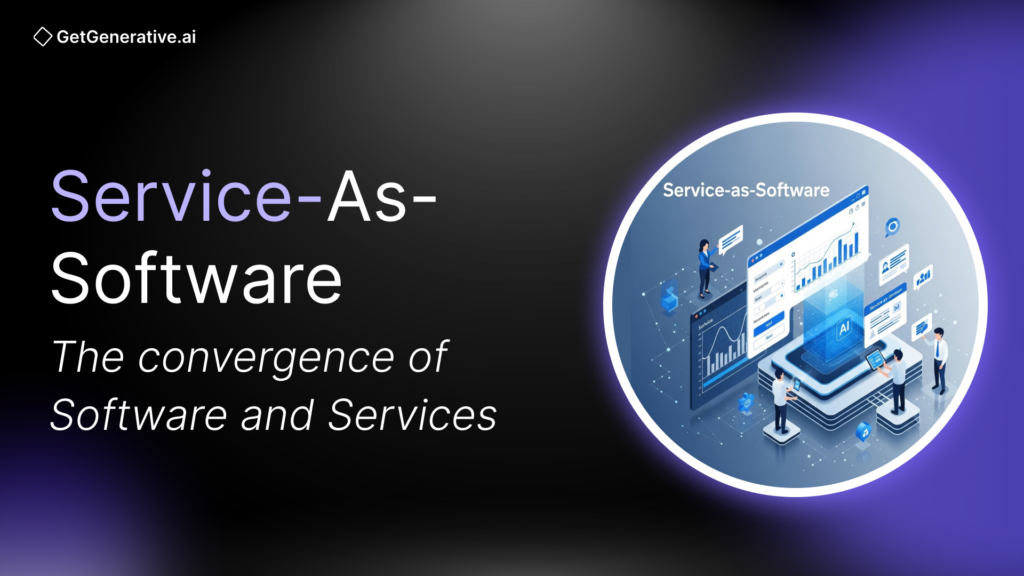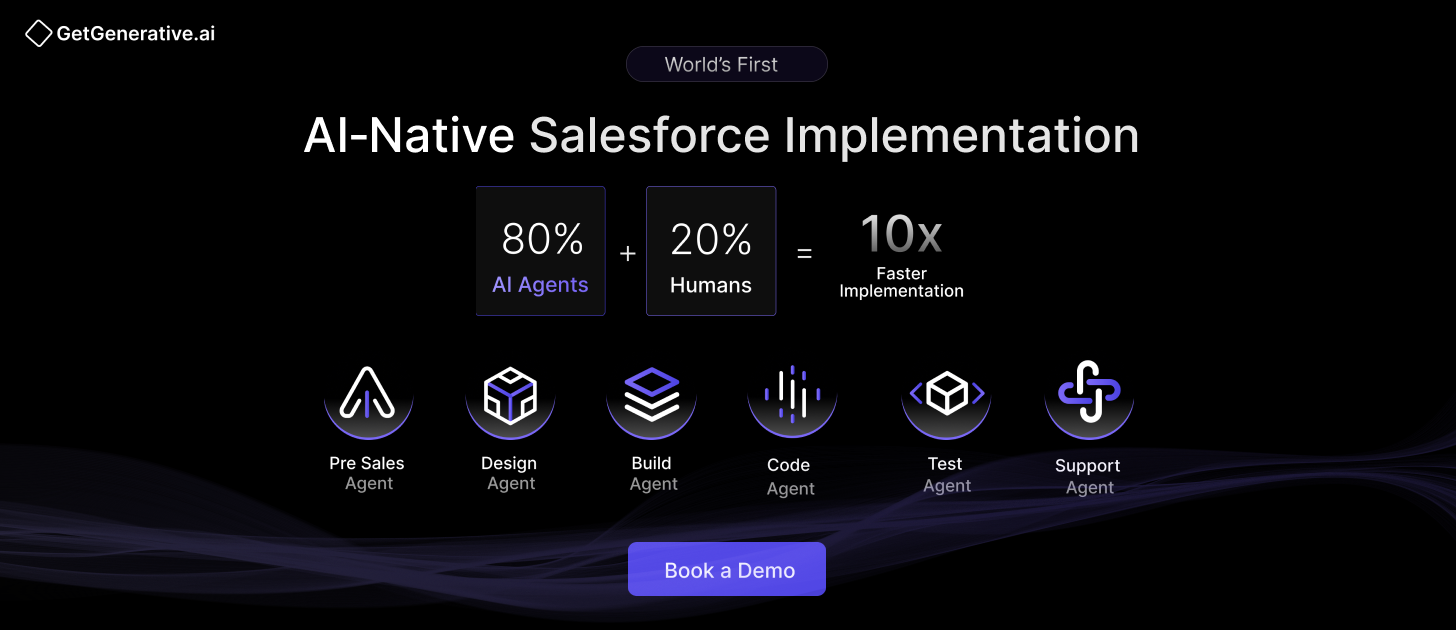Service-as-Software: The convergence of Software and Services
In a brilliant article by Ashwin Venkatesan and team at HFS, they articulate how services and software are converging, “where services are being codified as software and software is absorbing services,” leading to a collision between traditional service providers and software firms.
The Rise of Service-as-Software (SaS) in IT Services
Let’s unpack the concept of Service-as-Software (or “Services-as-Software” as HFS calls it). Traditionally, we think of Software-as-a-Service (SaaS) as cloud software delivered by subscription. Now flip that idea: Service-as-Software means taking what used to be delivered by human consultants or service teams and turning it into scalable software products. It’s a convergence of two worlds. As HFS Research observes, enterprise buyers can no longer treat services and software as separate categories – the lines have blurred. Both software companies and service providers are racing to embed intelligence, codify their IP, and deliver business outcomes through scalable, subscription models. In other words, everyone is trying to productize services and smarten up products.
Why is this happening now? A few catalysts stand out. First, advances in AI and automation are enabling us to codify expertise into algorithms. What a consultant does over weeks of analysis, an AI can do in minutes. Second, businesses are under pressure to be more agile, efficient, and resilient, especially after years of volatile markets and rapid tech changes. In fact, about two-thirds of enterprises plan to replace significant human-led services and processes with AI-led solutions within the next three years. That’s an astounding shift on the horizon, fueled by the need for speed and cost-effectiveness. Simply put, CEOs and CIOs are tired of paying for bloated software they don’t fully use, and tired of paying armies of consultants to make that software work. The old models of IT – paying for shelfware and paying for manpower – are breaking down.
HFS Research founder Phil Fersht captured this frustration bluntly: “SaaS is a bloated, overpriced mess … IT services are a glorified human labor business masquerading as innovation.” Enterprises have been “spending more and more every year on the same old software licenses and hiring more services people to make them work” – a cycle that simply cannot continue. The answer, emerging now, is to blend software and services into something better. Enter Services-as-Software — an AI-first, automated service layer that’s coming to obliterate everything in its path. No more billable hours. No more clunky SaaS. Instead of static tech plus expensive human help, companies want AI-powered, outcome-driven solutions that continuously adapt to their needs. This isn’t a minor tweak; it’s “a full-scale re-invention of enterprise technology”.
So, what does Service-as-Software actually mean in practice? HFS defines it elegantly. Services-as-Software “eliminates [the] BS – blending automation, AI-driven decision-making, and outcome-based pricing to deliver what enterprises need finally.” It’s an approach that is:
- Like services: it delivers expertise and decision-making.
- Like software: it’s automated, scalable, and subscription-based.
- Unlike traditional SaaS or consulting, it continuously learns from data and optimizes processes in real time.
In other words, Service-as-Software offers the best of both worlds – the knowledge and tailored solutions you’d expect from a consulting service, delivered with the scalability and efficiency of software. And because it’s AI-driven, it keeps getting better on its own. No wonder HFS found that 6 out of 10 enterprises expect to replace at least some of their professional services with AI-driven solutions in the near term. The market potential is enormous: HFS projects this new category will grow into a $1.5 trillion opportunity by 2035, siphoning off revenue from traditional IT services and even today’s SaaS vendors. In essence, whoever masters this model stands to reshape a trillion-dollar industry.
GetGenerative.ai: Filling a Gap in Salesforce Implementation
In early 2024, when we embarked on creating GetGenerative.ai, the category of Service-as-Software did not exist. We were Salesforce consultants who had seen the glorified human labor side of the business firsthand. Implementing or customizing Salesforce often felt like a slog of repetitive tasks: scoping requirements, writing user stories, configuring settings, writing code, testing, migrating changes, training users… If you’ve been through an enterprise software project, you know the drill. It could take months of effort, with countless billable hours spent on things that, to me, seemed ripe for automation. Why did we accept that an “8-week discovery phase” was normal, or that writing yet another set of test scripts was the best use of a smart consultant’s time? We believed we could do better. We envisioned AI Agents that would streamline every stage of a Salesforce project – essentially, a digital consultant that works side by side with the human team.
That vision gave birth to GetGenerative.ai. We began building it as an AI productivity tool specifically designed for Salesforce users and consultants. The idea was simple: augment human Salesforce experts with an intelligent layer that handles the heavy lifting. For example, instead of a consultant manually drafting a project plan or data model, our AI Agents can generate a first pass in minutes. We trained AI models on the best practices of Salesforce implementation – essentially capturing the knowledge of many senior architects and embedding it into our software. We ended up with a suite of AI “Agents” for each phase of the implementation lifecycle (Pre-Sales, Design, Build, Testing, Deploy, Support). These agents can analyze inputs (like business requirements or existing system configurations), and then generate outputs like solution designs, user stories, configuration code, test cases, deployment plans – you name it. Suddenly, tasks that used to take days of human effort could be done in an afternoon or automatically overnight. Our goal was bold: to implement Salesforce 10 times faster than the old way, without compromising quality.
Claiming “10× faster” sounded audacious. However, we had early reasons to support it. We ran a survey with our initial users – around 200 Salesforce professionals and project managers – to quantify the impact. The results floored us: on average, each user reported saving about 10 hours per week on routine tasks by using GetGenerative.ai, effectively freeing up 25% of their work time. Moreover, across their projects, they achieved a roughly 45% reduction in overall effort (measured in person-hours) to achieve the same outcomes. In practice, this meant that what used to be a 6-month project could be completed in 3–4 months, or a team of 10 could do the work of 18. These are internal survey figures, not a scientific study, but they gave us confidence that we were on to something real. One user told me that using our AI was like having an extra team member “who works lightning fast and never sleeps.” It didn’t replace the need for human judgment on critical design decisions, but it took care of the grunt work and ensured best practices were followed. Humans could focus on higher-level problems or simply go home earlier at night. This productivity boost is exactly what the Service-as-Software model promises: automation of the tedious stuff, so experts can spend time on what really matters (or so businesses don’t need to hire as many consultants in the first place).
From Product to GetGen Labs: An AI-Native Services Arm
Here’s an irony we didn’t anticipate: by creating a product to minimize the need for human professional services, we ended up launching our own services team. Let me explain. As more users adopted GetGenerative.ai, a pattern emerged. They loved the tool’s potential, but many companies still wanted help implementing Salesforce – even with the AI. Some clients said, “This platform is amazing, but we don’t have the in-house experts to use it optimally. Can your team just do the project for us, using your AI?” Initially, we hesitated. We built this to empower others, not to become another consulting firm. However, the demand was loud and clear: our customers wanted hands-on guidance – essentially “AI-powered consulting” – because we knew our product best and could combine it with our deep Salesforce expertise. We realized that to ensure our users’ success, we had to offer more than software; we had to offer service.
That’s how GetGen Labs was born. It’s our in-house consulting and implementation arm, but with a twist: everything we do in GetGen Labs is infused with our AI Tool and AI-driven methodology. We don’t show up with a blank slate and start billing hours to figure things out. We show up with playbooks and AI tools in hand, ready to deliver results faster and more predictably. Our team is relatively small and highly skilled; the AI handles repetitive tasks, allowing our experts to focus on high-level design, complex problem-solving, and client communication. In practice, this means that when a client engages with GetGen Labs, they can complete a project in half the calendar time with a lean team, and they’re not paying for a large team’s worth of billable hours. Our business model is more outcome-based, with pricing and engagement similar to a subscription model during the project, rather than the traditional “hourly rate” approach. This is very much in line with the Service-as-Software ethos: outcomes over effort, subscriptions over one-off deals, technology over manpower. As a founder, this was a big mindset shift – essentially blending a software startup with a services firm – but it felt like the right move to truly deliver value. The market appears to be rewarding this approach; clients who would never buy just a tool are happy to purchase a complete solution, where we take responsibility for the outcome.
Looking back, it’s almost funny: we set out to productize Salesforce services (to make it software), and ended up also servitizing our product (adding a service layer). But this dual approach is our competitive edge. We learn by doing – the projects GetGen Labs delivers feed back improvements into the software. And the software gives us a unique efficiency in delivering projects. It’s a flywheel. More importantly, it’s the model I believe many forward-thinking companies will follow: a tight integration of product and service, centered around AI. It’s exactly the “collision” HFS described between software firms and service providers – we became a bit of both. In the past, people would ask me, “So are you a SaaS company or a consulting company?” and I’d have struggled to answer. Today, I confidently say: we’re pioneering a new kind of company that does Service-as-Software. We deliver outcomes through a combination of software and expertise, powered by AI. And that is simply what the market is beginning to demand.
In Conclusion
In conclusion, the transformation of the IT consulting industry is underway, and it’s accelerating. Service-as-Software isn’t just a buzzword; it’s a fundamental reimagining of how technology expertise is delivered. It’s about AI-native services, continuous improvement, and aligning costs with value. GetGenerative.ai was born in this revolution, almost by accident at first, but now we carry the flag intentionally. Our story – from an AI productivity tool to a full-fledged AI-powered services lab – showcases how the consulting game can be changed. And we’re not alone. I believe we’ll soon see more startups and even large vendors blurring the lines, just as we did, all converging on the same endgame: delivering faster, better outcomes with fewer humans. This doesn’t mean humans become irrelevant; rather, our work becomes more strategic, creative, and impactful, while machines handle the drudgery.
To any fellow consultants, software builders, or enterprise leaders reading this: don’t fear this change – lead it. Embrace automation and AI in your operating model. Experiment with productizing your services or adding service value to your products. Focus on measurable outcomes for your customers. If you do, you’ll ride the wave of this $1.5T Services-as-Software revolution instead of being swept aside by it. As for us, we are incredibly excited to be on this journey.
At GetGenerative.ai, we’ve reimagined Salesforce implementation—built from the ground up with AI at the core. This isn’t legacy delivery with AI added on. It’s a faster, smarter, AI-native approach powered by our proprietary platform 👉 Explore our Salesforce AI consulting services
Sources: HFS Research’s “$1.5 trillion Services-as-Software market takes off” analysis; Horses for Sources blog by HFS (Phil Fersht et al.) on Services-as-Software; GetGenerative.ai internal survey data.




